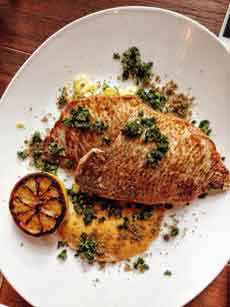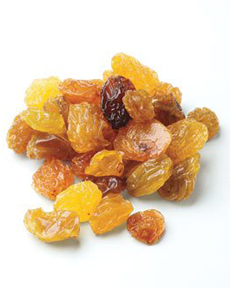TIP OF THE DAY: Gremolata, The Fresh, Homemade Condiment
 This roasted porgy fillet at Distilled NY has gremolata on top, raisin purée on the bottom. Photo courtesy Distilled NY. |
Gremolata is a fresh condiment that originated in Italian cuisine. It is too-little-known in the U.S., and may be most familiar to Americans as the accompaniment to osso bucco, braised veal shank.
The condiment consists simply of fresh chopped parsley, lemon zest and garlic. The addition of other green herbs is optional; we add basil or mint when we have it on hand. It has such lively flavor that you can cut back on salt. A pinch of gremolata spices up almost any dish: string beans) |
|
|
CLASSIC & MODERN GREMOLATA Gremolata (also spelled gremolada) is a relatively new condiment. According to Merriam-Webster, it first appeared in 1954, derived from the Italian dialect of Lombardy. What we don’t know is why these words were used (any guesses?): for the garlic, basil for the parsley. |
||
|
RECIPE: GOLDEN RAISIN PURÉE Some people use raisin purée as a substitute for refined sugar in baking. But it also complements grilled proteins, as Chef Sean Lyons of Distilled NY shows in the photo above. You can also use it as a dessert sauce, and you can replace the raisins with dried blueberries, cherries or cranberries. Ingredients 1. PLACE the raisins in a small pan, cover with water and bring to a boil over high heat. Reduce the heat to medium-low and simmer for 10 to 12 minutes until the raisins are plump. |
|
|
|
2. DRAIN the raisins, reserving the cooking liquid. Place the raisins and 1 tablespoon of the cooking liquid in a food processor or high powered blender and puree for 1 minute until completely smooth. Remove the purée from the food processor. 3. SIEVE the purée for additional smoothness, if desired. Keep in an airtight jar in the fridge for up to a month. †You can match dried cherries with cherry liqueur, dried cranberries with cranberry liqueur.
|
||



